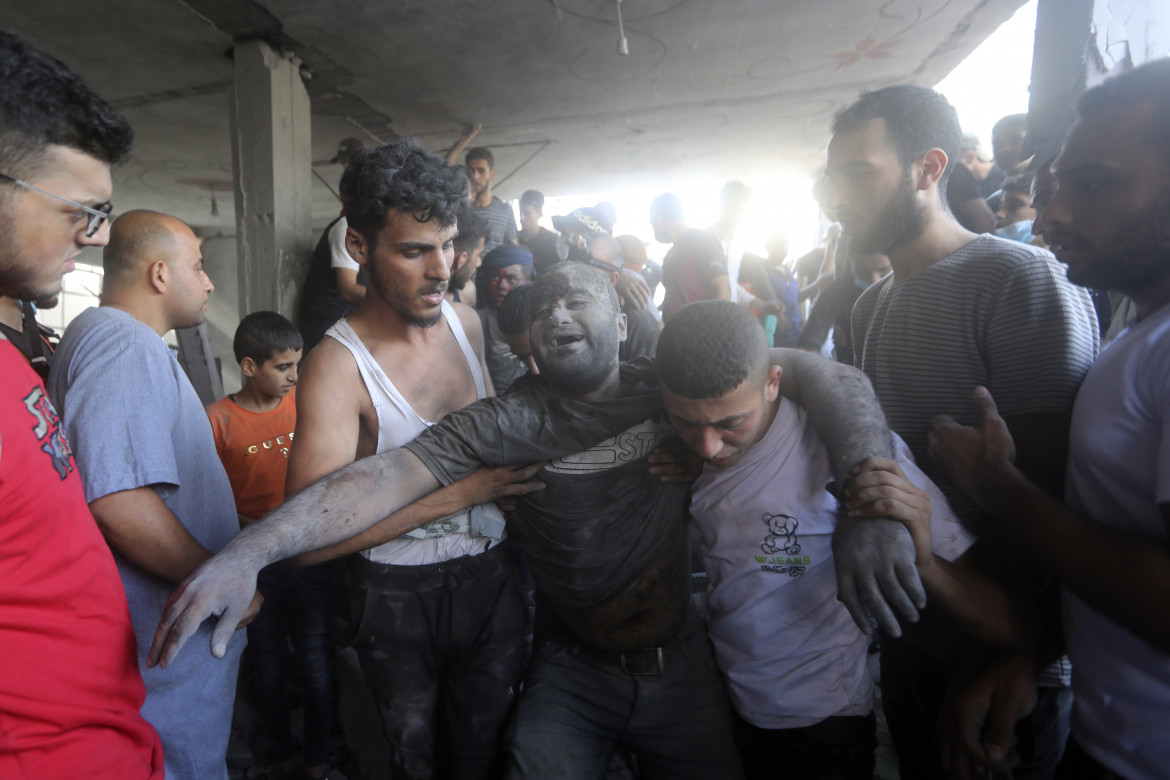Reportage
As bombings continue on civilian targets, rights groups warn of genocide
‘We remain convinced that the Palestinian people are at grave risk of genocide. … The time for action is now,’ human rights agencies warned.

A woman points to a pile of rubble: “This was my home. I don’t know what to say. We are defenseless.” She lived with her family in the Bureij refugee camp, south of Gaza City, population 46,000. The refugee camps have been hit hardest by the Israeli air force in recent days. There is no peace in Jabaliya.
They are still searching for those missing from Tuesday night’s attack. Finally, they were able to count the casualties from that raid with six bombs dropped on Jabaliya: 195 killed, 777 wounded and about 120 missing, probably dead. The rescuers – civilians digging up the rubble with their bare hands – said on Thursday that there was no one left alive underneath.
On Thursday, it happened again. The scenes are all too similar, with people digging through rubble with their bare hands: “My two sisters are beneath the rubble with their children. We are of no use. We can’t remove all this concrete. It’s too late, they must be dead by now,” said one young man to reporters from Al Jazeera, one of the very few TV stations that manages to report from the Strip, where the internet and telephone network is intermittent at best.
Those killed in Jabaliya on Thursday numbered at least 29, with many dozens wounded. Among the buildings targeted was an UNRWA school housing thousands of displaced people. A few hours earlier, Israel had bombed another school run by the UN refugee agency in Al-Shati camp: five were killed. More disturbing images came from Beach Camp, shot by Palestinian blogger Ahmed Hijazee, showing munitions raining down on the UNRWA school housing thousands of displaced persons: the munitions were spewing white powder, falling in great arcs as more were dropped from above.
These images recall the white phosphorus used by Israel in Operation Cast Lead. The people on the ground certainly thought so: the recording shows them shouting “Phosphorus, phosphorus” while trying to cover their mouths. It’s impossible at the moment to confirm whether this was indeed a use of such banned munitions; according to Amnesty International and Human Rights Watch, such munitions have been used in the last weeks in Gaza and southern Lebanon.
The Israeli operation began nearly a month ago and has caused widespread carnage: 32,000 Palestinians wounded and more than 9,000 killed, of whom 2,600 have never been recovered. They are still missing under the rubble, impossible to remove if you dig with your hands. About 1,150 children are also lying underneath the rubble, never recovered. Among the victims, in addition to 3,760 minors and 2,326 women (together making up 67 percent of the total), there are also 72 UN members and 135 doctors and paramedics.
The remaining medical personnel, exhausted but still alive, are working in just half the hospitals the Strip had before October 7: 16 out of 35 hospitals (46 percent) are no longer working. On Thursday, the Turkish-Palestinian Friendship Hospital, the enclave’s only oncology hospital, shut down because of air strikes and the fuel needed for generators running out.
On Thursday, Israeli Chief of Staff Herzi Halevi showed some openness to the delivery of fuel, but only when it runs out: “They have been saying for a week that the hospitals are going to run out of it, and it still hasn’t run out,” he said, conveniently failing to mention the 16 clinics that have already stopped working. Shortly afterwards, Prime Minister Netanyahu refuted his remarks, saying he “did not give any authorization” to transport fuel.
Also on Thursday, seven UN human rights special rapporteurs warned of “genocide”: “We remain convinced that the Palestinian people are at grave risk of genocide. … The time for action is now,” they wrote, pointing to the lack of aid, cuts to the water supply and the aerial bombardment of schools and shelters for civilians.
Those who can escape are doing so, but they are very few. After 500 people exited through Egypt’s Rafah crossing on Wednesday, very many have flocked to the large archway leading through the crossing and to the passport control counters. But the only ones that have been allowed to exit are foreigners and Palestinians with dual citizenship (400 people, many U.S. and Belgian, but also Italian aid workers) and 60 patients.
The children remain trapped inside, while UNICEF has made yet another appeal in a near-daily series, all falling on deaf ears: “Even wars have rules … The cost to children and their communities of the escalating violence will be borne out for generations to come. Children are dying at an alarming rate and being denied their basic rights.”
The escalation of violence is not even at full strength, according to Halevi, who says the Israeli air force is deploying less than half its strength. The violence is also taking place on the ground, all the way to Gaza City: “The forces are in the heart of northern Gaza, operating in Gaza City, surrounding it, and deepening [the ground offensive], and achievements,” he explained. In the evening, military spokesman Daniel Hagari spoke of attacks on Hamas positions and infrastructure.
By mid-afternoon, news agencies were reporting on heavy fire being exchanged between Israeli forces and Hamas militiamen in the Strip’s largest and most populated city: the ground invasion has been a reality for days and has now reached urban areas. Hamas is responding with mortar shells, grenades, and close-range clashes with infantry.
On Thursday, the 18th Israeli soldier was killed: Salman Habaka, a battalion commander. According to Israel, 130 Hamas militiamen have been killed. It is feared that some of them are actually civilians: also on Thursday, the Red Crescent reported gunfire on Al-Quds Hospital from military vehicles, with at least two wounded, a woman and a child.
Originally published at https://ilmanifesto.it/nel-mirino-ci-sono-i-campi-profughi-onu-rischio-genocidio on 2023-11-03
